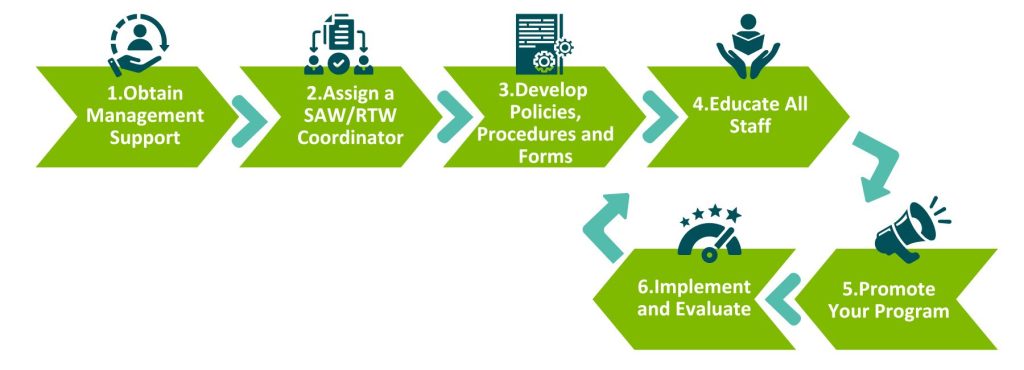Abilities Management Program
STAY-AT -WORK/ RETURN-TO-WORK PROGRAM
Workplace injuries, illness and accidents can be costly to an organization and to the workers within that organization.
Implementing a Stay-At-Work/ Return-To-Work (SAW/RTW) program when injuries do occur is one of the most effective ways to manage injuries and control associated costs.

Abilities Management looks at the worker and not the injury, what is it that the worker can still do versus what cannot be done. With the end goal of getting that worker back to full duties.
“Most physicians say only 5% of workers actually require time off after an injury. Therefore, 60-80% of lost work days involve medically unnecessary time off from work.” – Christian, 2000
Physical Injuries
It was often thought that when a worker becomes injured or ill, the worker should stay away from the workplace until they have fully recovered from their physical injury or illness and are able to perform all their regular duties.
The focus of a return-to-work program is to return the worker to the position that was held prior to the injury or illness. If full return to work is not possible right away, the SAW/RTW program can include modified work alternatives for workers to engage in as soon as possible. Modified work is a temporary change in regular work duties to accommodate an injury. Changes can be made to:
- work duration
- tasks and processes
- environment or work location
- equipment
- achievable – given your injury, are you able to physically perform the work
- safe – modified work should not endanger your recovery or safety or the safety of others
- constructive – modified work should contribute to your skill development and your return to full duties
- productive – your duties should be meaningful to the organization
Workers who participate in modified work return to regular duties faster than those who remain away from the workplace. On average, modified work programs decrease the amount of time workers spend away from work following an injury or illness and halve the number of workers that do not return at all. Modified work allows for workers to remain at work while recovering, which allows them to maintain independence, workplace relationships, skill levels and still contribute meaningfully to the workplace.
Psychological Injuries
There are differences between a physical injury and a psychological injury, though many of the processes are the same. Times are changing though and there is a rise in psychological injuries being reported now. It is imperative now more than ever to make sure that psychological injuries are included in a SAW/RTW program.
A Psychological injury refers to the emotional, behavioral, or cognitive impacts from an event or multiple events which occurred at the workplace, or in the context of work.
Some common types of events which may lead to a psychological injury include bullying and harassment, excessive workloads, micro-managing, workplace violence, or poorly handled HR processes.
For psychological injuries, WCB has a checklist for employers for what is required to adjudicate these types of claims. You can find the checklist here.
People may also develop a psychological injury in response to a physical injury which occurred at work.
Return To Work Strategies
When the injured worker is ready to return to work, it is important that the manager, human resources, workers insurance (if applicable), and treatment team are all working towards the same goal. It may be helpful to have a structured plan to support the return to work and to provide positive coping strategies to support the worker’s return. Below are some common strategies you may find helpful:

1. Recovery First
The initial focus should be around the recovery rather than on return to work.

2. Gradual Return
When it can be accommodated by the workplace a gradual return to work may be helpful.

3. Conversation Scripts
A common source of anxiety for people returning to work is talking with their colleagues about their absence. It may be helpful to develop a conversation script ahead of time.

4. Workplace Support
Additional workplace support may take many forms. This may include temporarily modified duties, or a temporary change to the reporting line.
Benefits and Responsibilities
- For Employers
Accommodating an injured or ill worker’s needs can benefit an employer in many ways, including:
- Retain experienced and trained workers.
- Reduce the recovery time of injured or ill workers.
- Reduce worker time lost from work.
- Increase workplace morale.
Employers have a legislative requirement referred to as the “Employer’s Duty to Accommodate” outlined in the Alberta Human Rights Commission.
- Duty to Accommodate
“The duty to accommodate in employment refers to an employer’s obligation to take appropriate steps to eliminate discrimination against employees and potential employees. Discrimination may result from a rule, practice or barrier that has a negative effect on a person with a need for accommodation based on the grounds protected under the AHR Act.”
Accommodation can include, but is not limited to, modifying rules, standards, policies and/or physical environments to ensure that the worker is not negatively impacted due to their injury or illness.
For more information on what an employer can request from an employee when accommodation needs to be made at work, see Alberta Human Rights:
- For Workers
For a worker to contribute the required information to develop and implement a successful SAW/RTW program, they need to be aware of what their role is and what their responsibilities are. It is an employer’s responsibility to ensure that the workers’ roles and responsibilities are communicated to them, and fully understood.
- For Unions
The worker representative, or where appropriate a representative from the union, should strive to protect the employees and ensure that the SAW/RTW program does not violate the collective agreement. They must visibly support and promote the stay-at-work/return-to-work program.
The 6 Steps to Abilities Management

- Step 1
- Step 2
- Step 3
- Step 4
- Step 5
- Step 6

Obtain Management Support
MANAGEMENT MUST BE ON BOARD
A successful SAW/RTW program requires commitment from the organization’s senior management.
This commitment is likely to take both time and financial resources to help injured employees return to work quickly and safely.
To help provide guidance to the organization, it is recommended that management endorse a policy statement related to a SAW/RTW program. A policy statement can help by ensuring consistency in messaging and provide direction for decision makers and disability coordinators. It is recommended that a policy statement for an organization’s SAW/RTW program include:
- The expectation that workers participate and assurances that the employer will assist the worker in getting back to work.
- A degree of flexibility in the program so it can accommodate a variety of different situations.
- A statement that the program will be available for work and non-work- related injuries.
- A commitment to reviewing the efficacy of the SAW/RTW program.
Industry Tip:
To help secure support from middle managers, appeal to both their business sense as well as their sense of compassion (i.e. benefits to employers AND workers)

Assign a SAW/RTW Coordinator
THE SAW/RTW COORDINATOR WILL HELP DRIVE THE CULTURE
Designating an individual to oversee SAW/RTW cases helps to ensure the program is running smoothly and efficiently. This helps to avoid confusion over who should be the primary contact for the WCB and who should be reviewing work-related medical documentation (i.e. job hazard analysis, physical limitations etc.) that relate to the worker’s restrictions.
Industry Tip:
If possible, avoid designating a direct supervisor as a SAW/RTW coordinator.

Develop Policies, Procedures and Forms
THESE DOCUMENTS CAN BE COMBINED INTO A SINGLE SAW/RTW PACKAGE
Policies
The presence of policies and practices impact both the chances of workers returning to work upon suffering an injury and how well they function upon returning.
For some organizations developing a more detailed policy can be helpful in providing clear structure for related procedures and can help to ensure that a process that is reflective of best practice is being followed.
Some key questions to consider while developing policies and procedures may include:
- How will we ensure that workers injured on-site are aware of the SAW/ RTW options and expectations prior to seeking medical treatment?
- How will the organization request the information required from the physician to safely accommodate modified duty restrictions?
The next step is to create a return-to-work procedure.
Procedures and Forms
When developing a SAW/RTW procedure it’s best to proceed sequentially from the moment the incident occurs.
The following are some elements you may consider including in your organization’s RTW procedures:
There are some key documents that your organization will also want to develop as part of the return-to-work program.
- A memo for the injured worker helping them through the return-to-work process
- A written initial offer of sedentary duties (prior to the injured worker going to the healthcare practitioner)
- A fitness for work form
- A job hazard analysis
- A modified duty job bank both for physical and psychological injuries
Industry Tip:
Staff may sometimes feel flustered by the SAW/RTW process at its initial onset. The worker’s responsibilities should be simple and straight forward (with assistance available if required).
WCB-Alberta has created a sample memo for workers as a starting point for employers to create their own memo.
You can find this in the resources.

Educate All Staff
STAFF NEED TO KNOW THE BENEFITS OF THE PROGRAM, WHAT IS EXPECTED OF THEM AND HOW THE ORGANIZATION WILL HELP THEM GET BACK TO WORK QUICKLY.
Once the related policies and procedures are in place the next step is to ensure all staff are made aware of the program.
Initial training on the organization’s SAW/RTW program should be included in new hire orientation and should be supplemented by regular refreshers for all staff.
There are many potential benefits for staff who are actively engaged in their organization’s SAW/RTW program which should be emphasized during training.
Industry Tip:
- Keep the messaging clear and concise.
- If possible, provide quick-reference materials and handouts (should an injury occur).
- Use training to reinforce the positive tone of the program.
REMEMBER: Refresher Training can be done informally!

Promote Your Program
(ONGOING)
If all workers are expected to engage in the organization’s SAW/RTW program, management should regularly advertise and support participation in the program. Staff may find the promotion of the program reassuring and indicative of management’s commitment to the program.
In order to successfully promote the SAW/RTW program, the organization should endeavor to regularly update their messaging to help ensure that the posters, brochures, pamphlets etc. do not become stagnant.

Implement and Evaluate
Once the SAW/RTW program is in place the last and final step is to use the program whenever an injury occurs and ensure that the processes are effective.
Evaluation is important to ensure that the SAW/RTW is achieving what you had set out for it to do—both for the workers and the employers.
To help ensure that affected workers had a positive experience with the organization’s SAW/RTW program it is recommended that quick evaluations be conducted after a worker has returned to work (regardless of any restrictions). These case-by-case observations can help employers to make simple changes or changes that may require immediate attention.
REMINDERS:
The importance of establishing and maintaining a positive and supportive culture around your organization’s SAW/RTW program cannot be overstated —it will influence the way managers, supervisors, injured workers and coworkers engage in and support the program.
SAW/RTW programs are great for employers and workers. The messaging may be different for employers and workers in the organization but everyone should know that it is a worthwhile endeavor.
Injury Investigation and Appeals
While following all the steps to creating a SAW/RTW program and having it readily available when needed will assist with successful SAW/RTW, there may be difficult situations and circumstances that arise. As an employer, it is important to be aware of the legislation and any available information that can help manage these difficult situations. It must be noted that all injuries, illnesses and individuals are different, making every case or claim unique. Investigations are mandated by Legislation.
Remember that WCB-Alberta outlines that for a claim to be covered the accident or injury must meet the 2 following criteria:
- must occur out of employment and be caused by an employment hazard (something in the workplace contributed to the resulting injury or accident)
- must occur during the course of employment (happens in a time and place consistent with the responsibilities and expectations of that employment)
WCB Appeals Process
Employers who are dissatisfied with an adjudicative decision have the right to request a review of the decision or to appeal the decision. A request for review or an appeal must be made within one year from the date of the original decision. The review and appeal processes must follow a specific sequence of steps. A decision must first undergo an internal review conducted by WCB. If an employer is still dissatisfied after the internal review, a request can be made for an external review through the Appeals Commission.
Resources
Conclusion
Organizations implementing a SAW/RTW program may find many of the resources included in the manual to be valuable references. Using this material as a starting point should provide employers with the direction needed to begin implementing a successful abilities management program.
For further information regarding the development of a SAW/RTW program it is recommended that organizations contact WCB Alberta:
Inside Alberta:1-866-922-9221
Outside Alberta:1-800-661-9608 (in Canada)
It may seem like a long and winding road…

